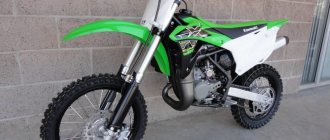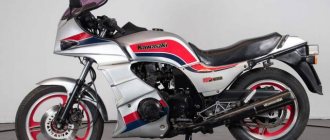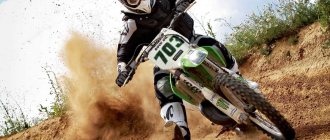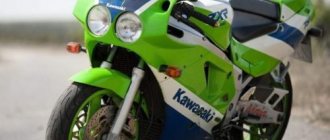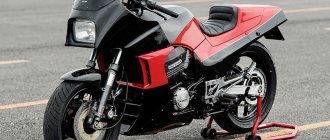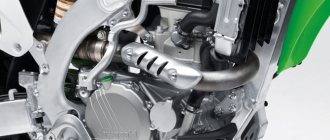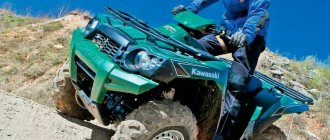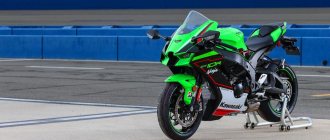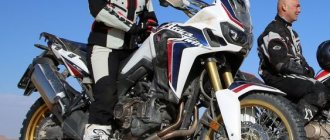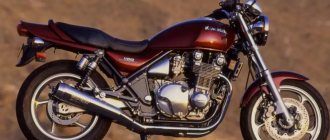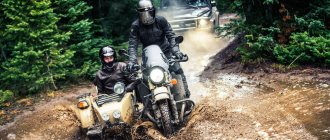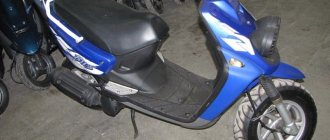Appearance
The Kawasaki KL250 Super Sherpa has a typical enduro look. The shape of the frame is similar to a motocross motorcycle. The wheels are spoked, the frame partially covers the main parts. The rear wheel is slightly smaller than the front, but the tire is thicker. The front fender of the latest version of the bike is raised high.
It is immediately clear that the motorcycle is well suited for rough terrain, because it has considerable ground clearance. In addition, the shape of the seat here is convenient for just such a ride. The classic white frame color of the latest version goes well with the gray elements. There are few chrome parts, and the most noticeable of them is the exhaust pipe.
Comfort
There are large mirrors in front, which are convenient to look into both on the highway and off-road. Of course, in the city a person will feel more comfortable on one of the road motorcycles. However, not always. For example, in some small towns in the CIS remote from regional centers, courtyard areas are sometimes poorly landscaped, and therefore enduro is most convenient there.
This bike is easy to handle at low to medium speeds. Unlike more powerful and heavier enduros, it is less likely to fall over somewhere in city traffic jams. So the car can rightfully be called universal, although first of all it is, of course, a vehicle for rough terrain.
Dimensions and weight
The car doesn't stand out in terms of dimensions, which is good. The dimensions and weight of the enduro are designed to ensure that this vehicle will cope with difficult sections of the road. Of course, technical characteristics are also taken into account.
The dimensions of the KL250 Super Sherpa are as follows:
- height – 1190 mm;
- width – 780 mm;
- length – 2080 mm;
- wheelbase – 1375 mm;
- seat height – 830 mm;
- ground clearance – 270 mm;
- curb weight – 128 kg;
- Tank capacity – 9 l.
It is important to consider the volume of the fuel tank when going somewhere outdoors. A well-thought-out route will eliminate unexpected problems. The ground clearance here is large, but it should not be overestimated. Otherwise, there is a high risk of damaging the main parts of the motorcycle while trying to conquer overly bumpy terrain.
Tool
In the back on the left there is a box in the form of a flask with tools. Many people are perplexed as to how to open it without a screwdriver, since the screw that locks it is made just for a screwdriver. It can be opened using the side of the ignition key.
The tool looks somewhat reminiscent of a Soviet one for bicycles or motorcycles, but it is of very high quality. For example, I was able to unscrew the drive sprocket protection only using a “10” tubular wrench from the kit; the Chinese store-bought ones couldn’t handle it and were made use of. It is also good to tighten the spark plug, since the handle of the key is narrow and, cutting into the hand, prevents you from tightening the spark plug too tightly and thus damaging the thread.
Specifications
The KL250 Super Sherpa does not stand out in terms of filling. Moreover, even at the time of its appearance on the market, the model was nondescript. But it is important to understand that this should not be considered a disadvantage, because judging by the engine size, it is immediately clear that this is definitely not a contender for winning competitions.
And weak motorcycles are valued by many precisely for their weakness, because this makes them more convenient and safe for some.
| Motor type | in-line, 1 cylinder, 4 stroke |
| Power | 26 hp |
| Torque | 25.5 Nm |
| Maximum speed | 132 km/h |
| Acceleration to 100 | 6.1 s |
| Fuel consumption per hundred | 3.7 l |
| Drive unit | chain |
| Transmission | six-speed |
| Frame | half-duplex steel |
| Rear suspension | pendulum, monoshock absorber, stroke 186 mm |
| Front suspension | telescopic fork, 36 mm, travel 230 mm |
| Rear brakes | 1 disc, 210 mm, 1-piston caliper |
| Front brakes | 1 disc, 240 mm, 2-piston caliper |
In addition, do not forget that the higher the performance of a motorcycle, the higher its cost. So the weak parameters of the KL250 Super Sherpa make this technique not only convenient for beginners and connoisseurs of a quiet riding style, but also for those who are not ready to spend a lot of money on it. About 110 thousand Russian rubles – that’s how much such a car costs.
Review of the Kawasaki KL250 Super Sherpa motorcycle (KL250-G, KL250-H)
So, let's start with the obvious - appearance. “An endurik is like an endurik,” a typical motorcyclist will say, “sporty, cross-country” it is called by “civilians” (civilians), but experts see the nuances: short wheelbase, narrow steering wheel, low seat. There are a minimum of plastic parts - the turn signals, the headlight fairing, the rear fender, the front fender, the side covers that cover the battery and the airbox compartment are made from it... oh yes - a container for tools. By the way, let's look at it in more detail: it is not located in the most favorable place - on the left side (when viewed from behind), under the rear wing, therefore, all the material under the wheel is always flying towards it. For this reason, I received the tool rusty. This container is not sealed, and opens in a very interesting way - longitudinally in half. It is fixed with one bolt, such a ridiculous shape that you can’t unscrew it by hand, but that’s okay - there is a slot for a Phillips screwdriver, but bad luck - the screwdriver is inside! Okay, everything was decided the old fashioned way: a tool in a rag, a rag in a plastic bag, the bolt was replaced with a leg from some bedside table.
The front wing is upper (there are non-hard versions with a lower location). I don’t know who to blame, but I got a motorcycle without a cool trunk (I’m sure it was there) and without the stock side passenger handles, there’s nothing to pull the motorcycle with, I’m trying to grab the fastenings for the passenger footrests  .
.
All remote controls are in place, the only disappointment is the lack of an alarm button. Another nice thing - the previous owner put in a switch from the Karpaty so that the light could be turned off (let me remind you that in the stock it lights up when you turn the key). A narrow steering wheel, which was unusual after the wide steering wheel of the snow leopard TTR 250. A simple instrument, but electronic - it displays the time, total mileage, 2 daily mileage counters and the speed itself; if we could add a tachometer here, there would be no price for it. It also has 3 control lamps - high/low beam, neutral and turn signals. The front fairing serves a purely decorative function; there is no wind protection on the motorcycle. The headlight is small, but it shines decently, the car bulb is 55/60 watt, H4 socket.
The fork legs have rubber corrugations that protect the pipes from dirt.
I would like to note that the location of the rear-view mirrors is not very good - they are located very narrowly, even I, not having a large build, could not position them properly - on the road, most of the mirrors are occupied by my shoulders. It is impossible to see a car approaching from the side in them; you have to rely on your ears and turn your head; there are 2 options here - either see the car on the side of you, or the cars behind you.
The engine is compactly located in the frame, nothing sticks out anywhere, everything is neat. From the factory, the caring Japanese installed engine crankcase protection, which has more than once saved my engine from very unpleasant contacts with hard surfaces. There are metal pads on the frame where the driver's feet come into contact with the pipes.
Supertrapp muffler, with variable sound - costs 9 (seemingly) set rings, the number of which changes the sharpness of the sound. Light and cute, he is no match for a stock fiend designed to strangle an already weak horse.
I won’t dwell too much on the pendulum - I’ll just say that it is made of two parallel pipes of rectangular cross-section and that the chain tension is adjusted by turning the expanding elements with marks applied to them.
The wheels are standard enduroy - 21 by 18, but the size of the rear tire needs to be especially taken into account. The factory recommends a rear tire with a width of 4.10 inches, which in the metric system corresponds to approximately 100 or a maximum of 110 tire, but you need to take into account that a 110 endura/road tire will be normal, but a cross tire like mine 110/100 does not fit a little in width, I had to trim the side spikes with a knife + the wheel became very large in diameter and the gap between it and the pendulum bridge remained somewhere around a centimeter (driving on clay quickly showed me how bad this is).
Electrically, the motorcycle is very simple - electric starter, turn signals, headlights, stopper - what else is needed for happiness?)) The battery costs 6 a/h (replaced with 7 a/h). By the way, there is no kick, which means that if the battery dies somewhere, be it in the wilderness, you will only have to rely on a friend who will push you, or look for a hill.
I’ll also add anthropometry here - height 163 cm, height at the crotch - 71 cm, 55 (very densely eaten and dressed ) kg weight. On a normal surface, I reach the ground with both feet, but only with their front halves, which I think is enough - after all, this is an SUV after all. The motorcycle almost doesn’t feel my weight, it almost doesn’t sag when landing, but it no longer likes people whose weight exceeds 75 kilos - acceleration becomes dull, it sag (although of course this is regulated).
) kg weight. On a normal surface, I reach the ground with both feet, but only with their front halves, which I think is enough - after all, this is an SUV after all. The motorcycle almost doesn’t feel my weight, it almost doesn’t sag when landing, but it no longer likes people whose weight exceeds 75 kilos - acceleration becomes dull, it sag (although of course this is regulated).
Subjective opinion.
How can you evaluate the behavior of a light enduro motorcycle? Light, fast, maneuverable, soft and flexible - this is in a few words, but in fact we can say with confidence that the characteristics of the engine of such motorcycles are favorable to beginners, because it doesn’t jerk or tear out of itself (and these are not the best off-road characteristics), soft suspension allows you to “swallow” small bumps and “stick” to large ones. While a hard bike rushes along the tops of the hillocks, the light bikes smoothly roll into each hole.
The first thing I thought about when I first sat on the Sherpa was: “why does the steering wheel wobble so much?!” At first I even thought there was something wrong with the steering column bearings or even with the fork stays. Then I rode - I realized that compared to the snow leopard, which had an oak fork, a wide steering wheel and a long wheelbase, my Sherpa looked like a dwarf. In comparison with the snow leopard, one can trace a deterioration in directional stability, difficult steering, an uncomfortable riding position in the rear and middle pillars - it would be more understandable to call such a position “cancer” - the steering wheel is very low.
The seating position during normal driving is quite comfortable, the hands are in the middle position - not raised or lowered, the steering wheel grips are pleasant to the touch, there is no desire to change, however, the left one always tries to slip off, no matter how much electrical tape you wrap there.
The legs normally fall into place, the knees are under the protrusions of the gas tank, although even here I think there is a drawback - on a normal enduro, the footpegs are positioned in such a way that when the driver sits all the way to the tank, the legs stand straight, that is, at an angle of 90 degrees to the hips . Immediately the legs are moved back, as on a road bike; but it would be good if they were carried - so you can’t put motocross motorcycle boots on them - they slide off all the time, you have to periodically “stick” the toes of your boots into the middle of the pegs, which is not good, because It is inconvenient to constantly throw your legs from the footrests to the levers. Speaking of levers, the gearbox “foot” is quite tolerable, but I frankly don’t like the rear brake. Firstly, it is located too close to the engine, but that’s okay - I bent it further, and secondly, it’s a little short, I can’t brake with the toe of my boot while standing on the footrest - the end of the brake tab is right in the middle of the foot (don’t think that the I have a healthy paw - only size 39), I have to place the toe of the boot on the brake paw separately from the footrest and... block.
Studded tires do not ride well on asphalt, they are noisy at speeds above 50, and they brake very poorly on it - simple brakes and little contact with the road take their toll. But off-road, not everything is so bad - there are more than enough brakes, except that there are problems with the information content of the rear (I already wrote why above). By the way, I read somewhere that some professional athletes specifically use worn-out rear brakes or even remove them altogether. The tires are Mitas, the grip is decent - I compared it with the behavior of the Chinese native snow leopard TTR 250-2 (R) - the snow leopard was thrown through the mud from side to side, my moto only occasionally twitched to the side.
I try to take turns on asphalt at minimum speeds - I’m afraid to tilt the studded tires too much, on the ground it’s better, you can also give the gas at the exit of the turn for showiness and a controlled drift.
The suspensions are excellent for civilian use, but as soon as you increase the pace a little, they begin to pierce at speed, kick, sway - in general, you can’t jump, especially since the hefty rear tire starts a terrible “hrrrr” when landing.
I assessed the behavior of the motorcycle when climbing – great! It’s not for nothing that this is all a mountain enduro (the name of the Sherpa is a mountain people), the motorcycle pulls from its place in the first and second, and in the third, of course, a little acceleration is already needed.
You can’t go long distance on it - the wide seat seems to be in fact not so comfortable: after the first hundred kilometers, your backside hurts terribly, if you drive a couple of hundred kilometers on country roads and off-road, it will hurt the whole next day)). But even if the seat were comfortable, such a low seating position on a long-distance ride is not the best solution and a short wheelbase will wear you out in 2-3 hours.
The only thing we can say about the engine is that it’s too small, whatever one may say, the service interval - during enduro use the oil (I use Motul 5100) is changed every thousand km. According to rumors, the engine is not very reliable and a little capricious. By the way, after the first thousand km we had to change the entire “head” and rings. For 30 thousand km, there was already a non-original piston on the odometer, and there was wear on it too. Did the previous owner not spare the motorbike?... There was overheating, I doubt that it happened to me, apparently that’s why I had to invest. In terms of power, I can say that my motorcycle’s maximum torque begins to appear somewhere around ¾ of the entire speed range; in fact, the specifications indicate 6500 rpm. The motorcycle accelerates quickly, while forcing your left foot to rattle like an automatic machine to shift up - the gears are a bit short, every 10 km/h, starting from 10, you need to increase them.
Vibrations when driving are absolutely not felt at any speed, but the mirrors shake unpleasantly.
When riding together, the Sherpa is in no way inferior to its tougher brothers, but to be honest, I have absolutely no desire to get into shit on it anywhere.
There were a couple of crash tests: I fell at a speed of about 30 km/h, sliding to the left side on the dirt road - the rear left turn signal was torn off and my shoulder knocked over the right mirror when flying over the steering wheel. I replaced the turn signals with Chinese ones and lifted them up so that they can’t be broken. The front side does not suffer at all - the moto lands on the steering wheel handle and the front wheel axle bolt, so neither the headlight nor the turn signals are affected. There was a crash on the asphalt - I slowed down in front of the car, also at a speed of about 30, tried to steer out and very slightly caught the car with the right step on the bumper and door - I caught a wobble and then slid to the right side. Remained safe and sound (thanks to God and the equipment), the motorcycle as a whole also got off easy - the steering wheel was bent on the right.
Conclusion/results.
In conclusion, we can definitely say that the motorcycle is very worthy, you can find a lot of applications for it - be it fun rides on the weekend or everyday riding on business or to work. It is very convenient for girls, beginners and fishermen. One of its main advantages, like all enduros, is that you can ride it in winter.
The main thing before buying such a specific motorcycle is to soberly assess your needs, otherwise you may be very disappointed in it, mistaking it for a hard XR250 type.
Thank you all for your attention and good luck on and off the roads!
History of changes
During the production period of this bike, no significant changes took place. This is probably good, because the motorcycle was originally designed in such a way that nothing had to be changed. Another advantage of this is that connoisseurs of old enduros will certainly appreciate the fact that production ceased relatively recently, but the technology appeared at the end of the last century.
On the one hand, this turns the KL250 Super Sherpa into a kind of rarity, but on the other hand, it does not greatly affect the ease and cost of maintenance. After all, spare parts are still not difficult to get, although not as easy as for popular bikes among the masses.
Modifications
Kawasaki kl250-G is a low wing model.
Kawasaki kl250-H is a high wing model.
Since the start of production, the bike was launched in 2 modifications, which were unofficially nicknamed “Japanese” and “Greek” - according to the main markets. The Greek one was sold in Europe, the Japanese one came to Australia, America, and of course Asian countries.
The difference between the modifications was only externally. The filling is identical .
- Kawasaki kl250-G (Japanese version) looked like an ordinary road bike with a wing tightly pressed to the front tire.
- The Kawasaki kl250-H ( Greek modification) received a standard enduro front wing, pulled up right under the fairing. The frame design was also changed, as a result of which this version was slightly smaller (by 5–10 mm) in all overall dimensions.
and competitors
Suzuki and Yamaxa provided their answers to the enduro version. Honda remained silent for some time, but soon introduced three versions at once - enduro, motard and duak-sport.
Suzuki called its version djebel 200 , positioning it for the Japanese markets. She went into production in 1993. Two years later, the DR200SE is sent to Europe, differing from the source only in appearance.
Suzuki Djebel 200 is another small-capacity endurik from the land of the rising sun.
Differences from Kawasaki:
- 2 valves versus 4 valves;
- 20 hp versus 26;
- 5 gearbox stages versus 6;
- drum on the rear axle against the disc.
The Japanese version closed in 2005 , the European one in 2013 .
Note that the competitor has a smaller engine. With equal volumes there could be complete compliance.
Yamaha XT250 Serow
Yamaha's XT250 Serow is now in its third generational change and is still in good demand.
Yamaha dubbed its brainchild the XT250 Serow. Launched into production in 2005 and is still in production.
- also 2 valves versus 4 ;
- injector (since 2008) versus carburetor;
- 21 mares versus 26;
- 5-speed gearbox;
- disc brakes of our own design.
It’s curious that the brand’s injector is somehow strange. With the same engine parameters, power and torque decreased.
Honda CRF250
The Honda CRF250L enduro motorcycle model had a simple layout and belonged to the budget class of bikes.
Honda introduced the CRF250 model. Modification L - enduro , M - motard , Rally - dual-sport . All were launched in 2012 except the last one. She's in 2021.
Models are distinguished by liquid cooling, fuel injection, and an optional ABS system (starting in 2021).
Production continues.
What do the owners say?
Among the owners of the KL250 Super Sherpa there are many who have previously used a sports bike. This is not surprising, because people often want variety. After a fast sports bike, switching to a weak off-road bike is an interesting and vibrant experience.
Many note that the bike is able to overcome rather harsh rough terrain, which is confirmed by photos and videos. However, almost every review says not to push this bike too hard. Otherwise, it becomes dangerous both for the equipment and for the rider.
Judging by the reviews, the KL250 Super Sherpa is very convenient in an average city. However, they note that the sounds of this bike sometimes cause discomfort among others. However, many other classes of motorcycles are distinguished by this feature.
According to the description of those who have been touring on enduro bikes for a long time, this is not the best choice. However, if you do not plan to travel anywhere outside the familiar region, according to them, this car will be a suitable option among the budget ones.
In conclusion, it is worth noting that the Kawasaki KL250 Super Sherpa is a great machine for touring and those who prefer mild off-road motorcycles. The fact that the machine is low-performance has its advantages, and for some, these are the bikes that are the priority. After all, not everyone feels comfortable with strong acceleration and high speed.
